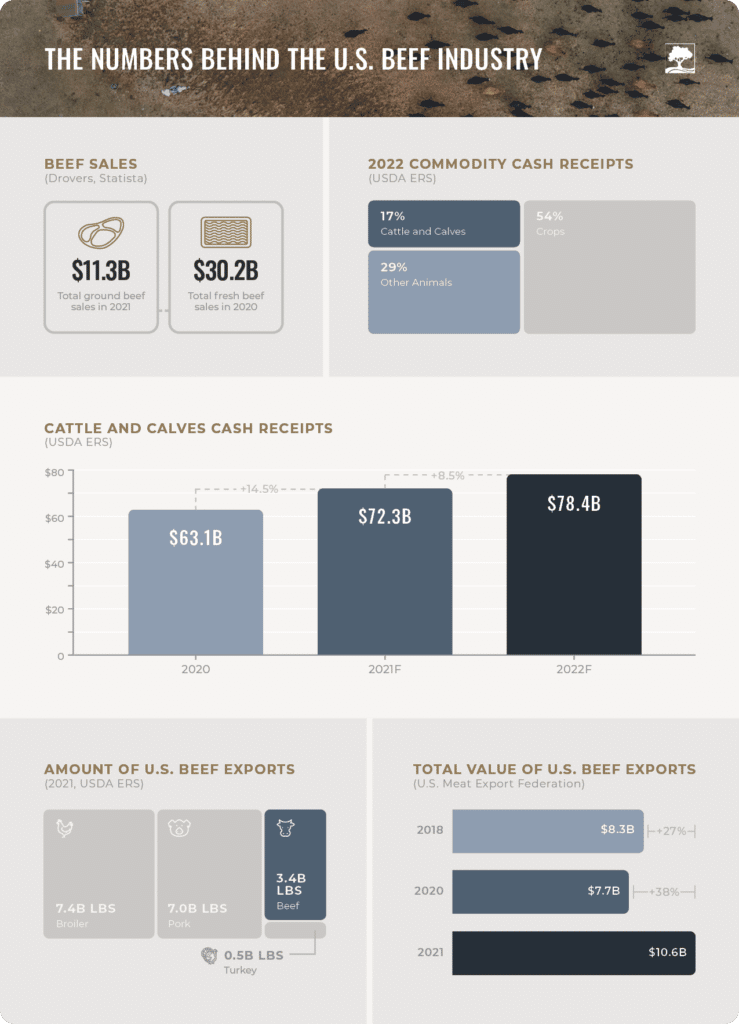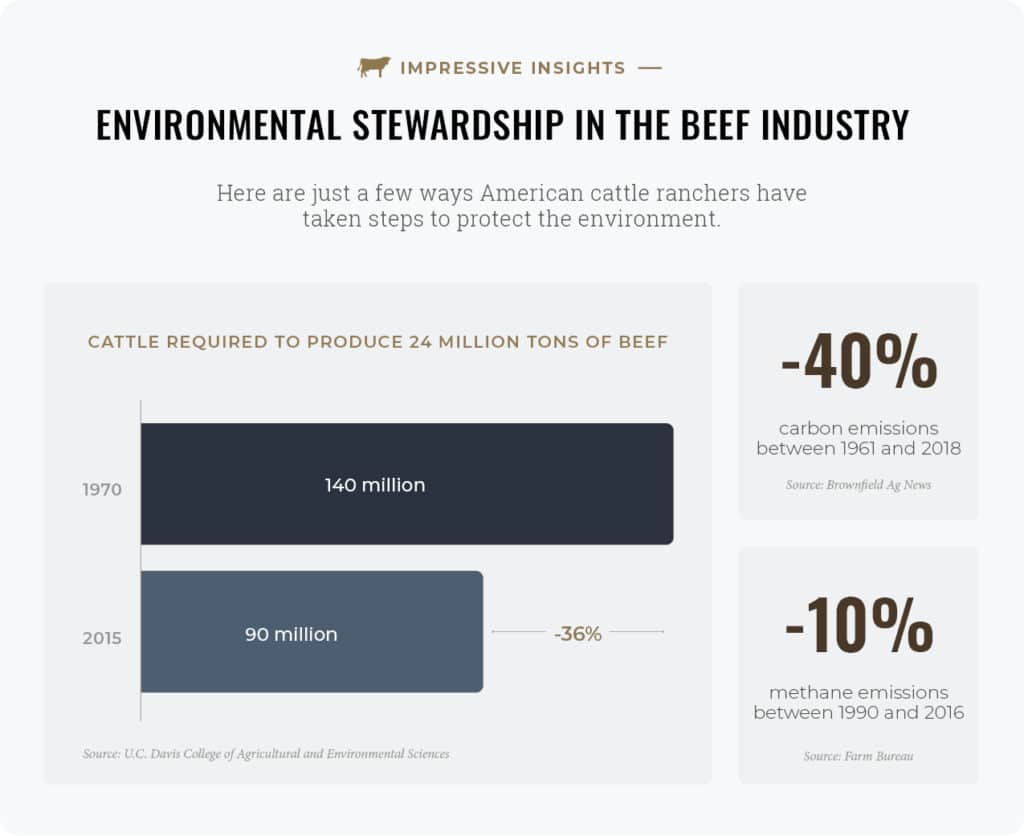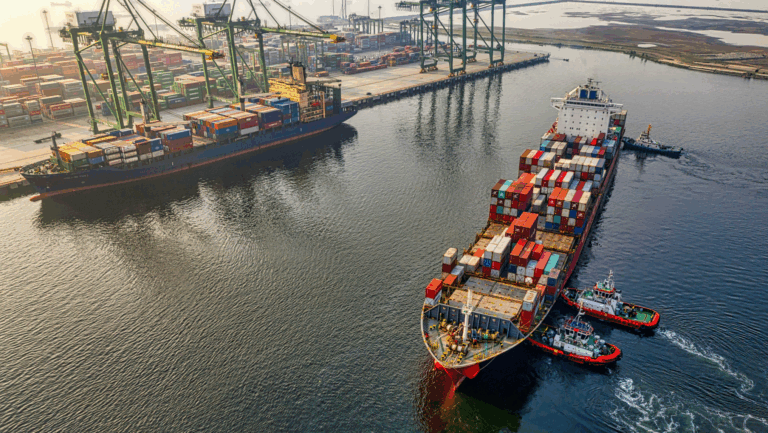National Beef Month: Celebrating American Cattle Ranchers
Cattle ranchers in the U.S. work hard 365 days a year—contributing to both our economy and ecosystems.
The economic and cultural impacts of the American cattle industry are extensive. With over 700,000 cattle and calf operations across the nation, the U.S. is the largest producer of beef in the world. It is an industry that is deeply ingrained in American culture and is a key contributor in the effort to increase food security by providing nutrient-dense food.
Here are some interesting facts about the U.S. cattle industry:
- Beef is the largest agricultural industry in the U.S with the highest cash receipts.;
- U.S. beef production totaled 27.9 million pounds in 2021; and
- There are 91.9 million head of cattle in the U.S.
National Beef Month is a time to show our appreciation for the cattle ranchers who rise before the sun each day to provide food for the world. More than ever, ranchers are sharing their stories on social media platforms to share what animal agriculture means to them and why it’s important. As a result, they are gaining increased recognition for their role in sustainability and global food security.
The Economic Footprint of the American Cattle Industry

The scope of the American cattle industry continues to expand and generate positive economic activity. In 2022, total cash receipts from cattle and calves are expected to increase by 24 percent compared to 2020. As the beef industry continues to grow, so does its positive impact on the American economy.
American Cattle Ranchers and Environmental Stewardship
Cattle ranchers depend on healthy soil and land for the well-being of their cattle and operation. As a result, they place environmental stewardship at the forefront to ensure the longevity of their operation. They have worked hard over the years to optimize the productivity of their ranch without comprising the health of their land. According to a study by Oklahoma State University, the American beef industry has one of the lowest carbon footprints in the world. In fact, the beef cattle industry contributes only two percent of the overall U.S. greenhouse gas emissions. A variety of factors including advanced technology, animal management techniques, the quality of cattle feeds, and cattle genetics have contributed to this environmental triumph.
Cattle ranchers are motivated to protect the environment because they are personally impacted by the repercussions of a changing climate. For instance, U.S. farmers and ranchers incurred $145 billion in losses from severe weather events in 2021. Due to these challenges, cattle ranchers are taking measures to protect their land.
“Farmers and ranchers are the original conservationists. Environmental sustainability is at the forefront of their daily decisions on the ranch; if they don’t continuously consider factors like soil health and carbon sequestration, water and runoff management, dust control and methane capture, then they will not be able to raise healthy animals and stay in business.”
Here are just a few ways American cattle ranchers have taken steps to protect the environment:

Protecting the Land with Grazing
Through innovative agriculture techniques, the American cattle industry has not only minimized its carbon footprint but is actively contributing to protecting the soil health and preserving farmland. One such regenerative practice is rotational grazing. When cattle graze on pastureland, it improves soil health by preventing erosion, improving carbon storage, and promoting biodiversity.
“A lot of people are worried about carbon dioxide in the atmosphere. Grazing provides storage – it stores the carbon in the soil.”
Each day, an average of 2,000 acres of farmland are developed. Using farmland for grazing helps preserve land that would otherwise be developed and lost forever. By preserving this land, wildlife habitats are also protected.
In addition to supporting healthy soil and conservation efforts, grazing also prevents wildfires. The combined benefits of grazing make it a powerful technique with bountiful impacts.
“Today’s cattle producer may ride a horse – but they have a tablet in their saddlebag, leveraging precision agricultural technology to reduce environmental impact and maintain the highest quality in our product. The American beef industry is sustainable – but the current lack of dialogue and understanding between cattle producers and policymakers is not.”
AgAmerica Is a Proud Supporter of American Cattle Ranchers
Rooted in American agriculture, we understand that each ranch is unique with its own set of goals and challenges. Amid volatile commodity pricing and shifting market demand, our flexible cattle loans leverage land equity to equip ranchers with the necessary capital to build and support an environmentally and economically sustainable operation.
If you are interested in learning more about AgAmerica and how we can serve you, explore our financing solutions for cattle ranchers.






